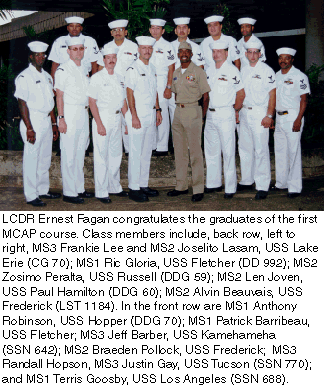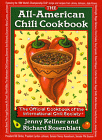
Culinary Arts Program Boosts Skills of MIDPAC Sailors
By Lt. Cmdr. Ernest Fagan, SC, USN
Group Supply Officer, Naval Surface Group Middle Pacific,
Pearl Harbor, Hawaii
Question: What is the only thing harder than setting up training? Answer: Setting up training for mess management specialists! But thanks to a new program in Pearl Harbor, MSs in Hawaii are benefiting from a local partnership between MIDPAC and a local culinary arts school.
The inaugural MIDPAC Culinary Arts Program (MCAP) completed its first weekly session March 22-26, 1999. Fourteen sailors from nine Pearl Harbor -based ships and submarines participated in a partnership with Leeward Community College, a local institution with a superb food service curriculum. The school also enjoys the advantage of having chef-instructors from the local hotels on its faculty, an aspect that the students recognized right away. "I can’t believe how much I learned in just a week," said MS1 Anthony Robinson of the USS Hopper.
The students received training in sauces, cooking techniques, breads and pastries, cake decorating, garnishing, platters, ice carving, and hors d’ oeuvres – all tailored for preparation using shipboard facilities and to complement Navy recipe cards. "Some schools teach things you can’t use on the ship," said MS2 Braeden Pollock of the USS Frederick. "Here everything was designed to prepare in our galley."
As MIDPAC’s group supply officer, one of my collateral duties is to perform preliminary evaluations for the Ney award. As I visited various commands, it was clear some ships could not realistically compete. All of them were motivated, prepared and served good food, and effectively managed their accountability. But only few had the personnel with the culinary arts knowledge that separates a Ney winner from a runner-up. So with the sole purpose of closing that talent gap, the MIDPAC Culinary Arts Program (MCAP) was born.
 The mess management specialists
aboard Ney winners deservedly get to attend a civilian
culinary arts institute to receive additional training.
But no training was available for the food service
operations that consistently compete but cannot break
through to be number one or a finalist in their category.
Occasionally these ships may be lucky enough to get one
or two members from a Ney competitive ship, but how do
the rest of the MSs learn to improve their skills? The
answer is low-cost, high quality, intensive local
culinary arts training!
The mess management specialists
aboard Ney winners deservedly get to attend a civilian
culinary arts institute to receive additional training.
But no training was available for the food service
operations that consistently compete but cannot break
through to be number one or a finalist in their category.
Occasionally these ships may be lucky enough to get one
or two members from a Ney competitive ship, but how do
the rest of the MSs learn to improve their skills? The
answer is low-cost, high quality, intensive local
culinary arts training!
The course was designed from the ground up specifically for the shipboard MS. I invited faculty chefs to tour various ships and observe the environment that the students operate in. Lee Allen Fung, Leeward curriculum director and local restaurateur, judged some of the food events during the Surface Line week food competitions held last summer. "I was quite surprised at the talent level," said Fung. "I had no idea they could make products this good on a ship." These tours and contests were vital in ensuring the training did not waste valuable classroom time on the basics and for preparing an effective course curriculum.
All of the participants lauded the quality of the training. Many created products for the first time in their careers like MS3 Justin Gay of the USS Tucson. "It’s amazing how vegetable carvings can become art in just a matter of minutes."
MS2 Glenn Joven of the USS Paul Hamilton believed the class worked because the students and the instructor were in synch. "The chefs didn’t hold back … once they knew what we were capable of, they were free to teach as much as we could handle."
"Hands on" was the theme at this school, as everyone got deeply involved in every aspect of the training. MS3 Frankie Lee of USS Lake Erie got to try his hand at ice carving. "This is the best school I’ve ever attended," said Lee, "because you just don’t read, you do things."
The instructors were enthusiastic about the course as well. Dennis Kealoha, who taught breads and pastries, was impressed with the maturity and discipline of the Sailors. "Most of my students are civilians, and they have a hard time keeping up and coming to class on time. These guys [Sailors] are really dedicated and eager to learn." In fact the instructors were so energized by the pace of the classes that the students had to rein them in. "We had to beg for a break," joked MS1 Ric Gloria of USS Fletcher.
Funding for the initial class was provided by Commander, Naval Surface Forces, Pacific Fleet. "You have to recognize cost effective training and take advantage when its available," said Force Supply Officer CAPT John Pledger. While TYCOM funding may not always be available, the cost per person is minimal, with no per diem or travel expenses. "Not having to use TADTAR funds for specialized training is a big plus," added Pledger, "and the supply officers now have a strong tool to motivate their cooks."
Eligible candidates should be E-4 to E-6, have between nine to 12 months left at their command, and be in a position to utilize skills learned in the course. The course is offered quarterly to ashore and afloat Pearl Harbor-based MSs. Class size is limited to 15 and, with proper scheduling a ship can train its top four to six MSs in just under a year.
The MIDPAC Culinary Arts Program is up and running. With a little time, money and effort, Pearl Harbor should be home to some of the best-trained mess management specialists in the Navy.
Navy Supply Corps Newsletter story from the July/August 1999 issue.
LCDR Ernest Fagan has been at MIDPAC since June 1997. Previous tours include Defense Contract Management Command International; USS Frederick; NAS North Island; and USS Okinawa.
For more information on the MCAP, contact him at fagane@midpac.navy.mil, or visit the MIDPAC web site at http://www.midpac.navy.mil.
| Bulletin Board | Keyword Search |
| Bookstore | Links |
| About Us | Recent Additions |

